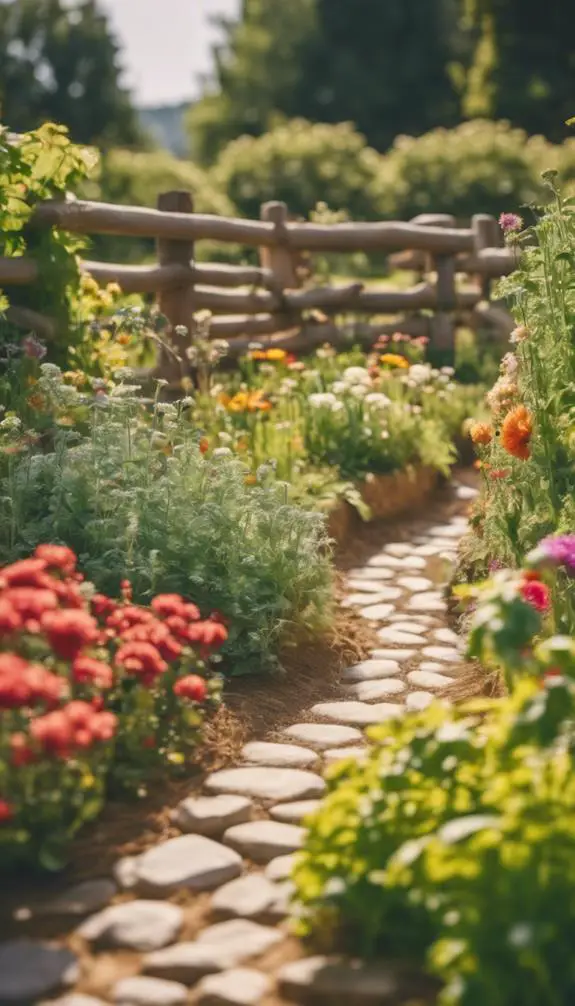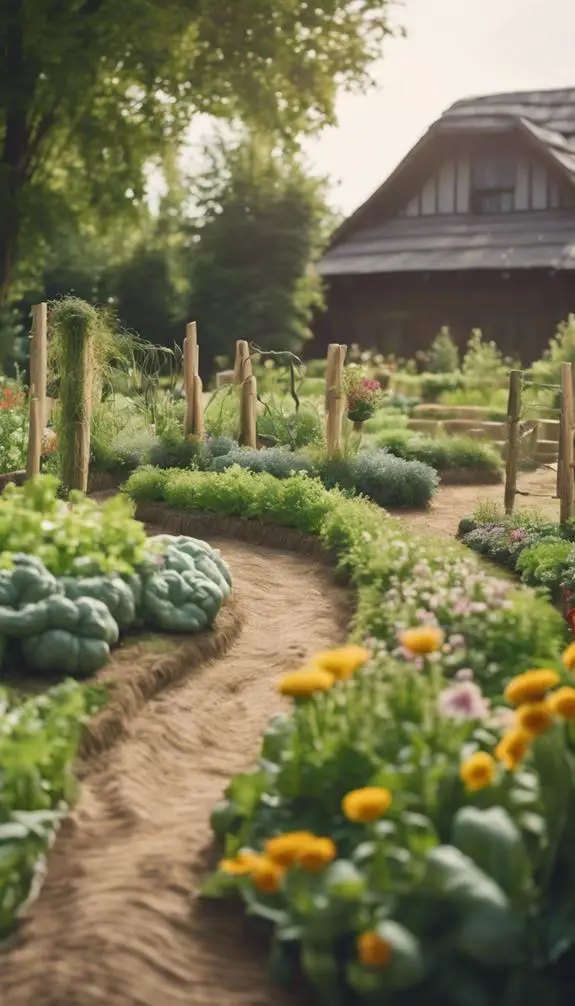As you prepare to venture into your straw bale gardening journey, having a solid plan is crucial to give careful thought to the layout of your garden. You'll want to identify a spot that receives at least six hours of direct sunlight and is close to a water source. But that's just the beginning. You'll need to determine how many bales you'll need, create a pathway system, and strategically position your bales to minimize intense sunlight and heat buildup. With a solid layout in place, you'll be well on your way to a thriving and productive garden – but what are the key considerations to keep in mind as you get started?
Summary
- Assess the garden area to determine the best location for straw bales, considering sunlight, wind direction, and accessibility.
- Choose a location with at least 6 hours of direct sunlight per day and proximity to a water source, ensuring a balanced sunlight and shade layout.
- Plan the garden layout and bed configuration, deciding on dimensions and bale size to optimize space and mature plant size.
- Position straw bales strategically, facing them north-south to minimize intense sunlight and heat buildup, and leaving room for air circulation and easy harvesting.
- Ensure a well-planned pathway system with materials like wood chips or gravel, guaranteeing organization, accessibility, and aesthetics.
Assessing Your Garden Space

When preparing your garden space for straw bale gardening, assess the area to determine the best location for your bales.
Consider your garden's history: has it been used for other types of gardening in the past? Are there any existing features, like slopes or drainage issues, that could impact your straw bale garden's success?
During your space evaluation, take note of the area's sunlight patterns, wind direction, and accessibility. You'll want to choose a spot that receives at least six hours of direct sunlight a day and is close to a water source.
Also, consider the mature size of the plants you'll be growing and leave enough space for air circulation and easy harvesting. By carefully evaluating your garden space, you'll set yourself up for a successful straw bale gardening experience.
Choosing the Right Location
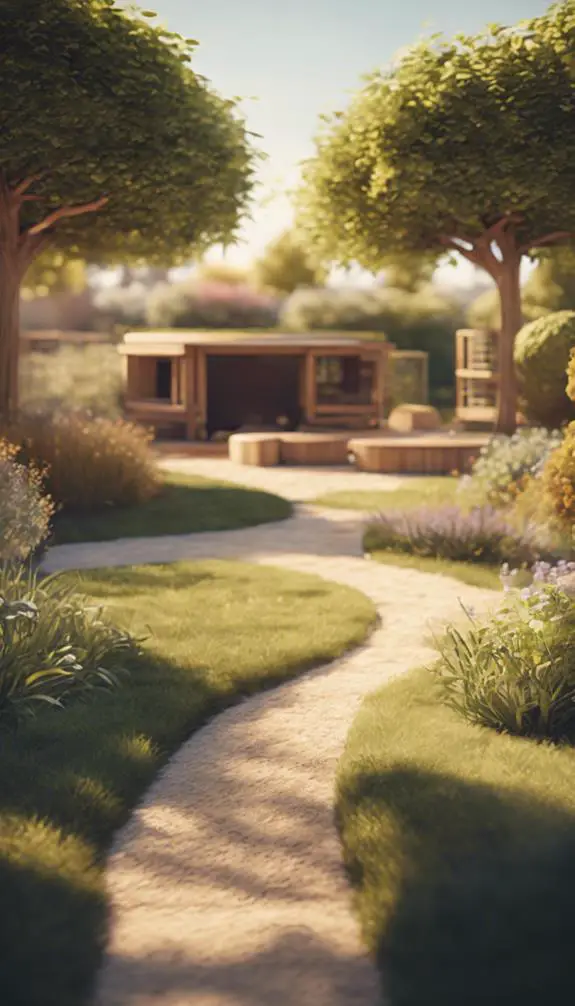
You'll want to choose a location that receives the right balance of sunlight and shade, as straw bale gardens require at least 6 hours of direct sunlight per day.
Additionally, consider the soil and drainage conditions of the area, as straw bales can be prone to waterlogging.
Sunlight and Shade Balance
How much sunlight does your straw bale garden need to thrive?
Most vegetables and fruits require at least six hours of direct sunlight per day. However, it's crucial to take into account the shade patterns in your chosen location.
Observe the area at different times of the day to identify sunlight pockets where the sun's rays penetrate through trees, buildings, or other obstructions. You can also use a sunlight calculator or app to determine the best spot.
A balanced sunlight and shade layout will guarantee your straw bale garden receives the right amount of light for healthy growth while minimizing heat stress. By carefully selecting the location, you'll be able to create an ideal environment for your straw bale garden to flourish.
Soil and Drainage Considerations
With your straw bale garden's sunlight and shade balance in mind, it's time to ponder the soil and drainage conditions of your chosen location.
You'll want to assess the soil composition, considering factors like pH levels, nutrient availability, and organic matter content.
Straw bales thrive in well-draining areas, so you must identify any potential drainage issues. Check for low-lying spots or areas where water tends to collect.
You may need to create a slight gradient or install a French drain to guarantee excess water flows away from your bales.
Proper soil and drainage conditions will help your straw bale garden flourish, so take the time to get it right.
Accessibility and Space Needs
Considering the layout of your yard, accessibility and space needs become crucial factors in choosing the right location for your straw bale garden.
You'll want to identify any garden obstacles that could hinder your ability to tend to your garden, such as steep slopes, narrow pathways, or areas with poor drainage.
Guarantee your straw bale garden is senior-accessible by selecting a location with minimal walking distances and minimal bending or lifting required.
Ideally, your straw bale garden should be situated close to a water source and within easy reach of tools and equipment.
Determining Bale Quantity Needed

When determining the quantity of straw bales needed for your garden, you'll need to weigh the size of each bale, the dimensions of your garden bed, and how you plan to allocate space within it.
For example, will you be creating a single large bed or multiple smaller ones? By taking these factors into account, you can accurately calculate the number of bales required to achieve your desired garden layout.
Bale Size Considerations
Your straw bale garden's success hinges on allocating the right number of bales, which is where bale size considerations come in.
You'll need to think about the size of your bales in relation to the space you have available and the weight they'll hold. A standard straw bale typically weighs around 30-40 pounds and measures 2x2x4 feet.
When choosing bale size, consider the weight and handling implications. Larger bales may be more cost-effective, but they can be heavier and more difficult to handle. Smaller bales are lighter and easier to manage, but you may need more of them to achieve the same coverage.
Balance these factors to guarantee your straw bale garden gets off to a strong start.
Garden Bed Dimensions
Now that you've chosen the right bale size, it's time to determine how many bales you'll need to create your straw bale garden.
To do this, you'll need to plan your garden layout and bed configuration.
Decide on the dimensions of your garden bed, considering the space available and the mature size of your plants.
A typical straw bale garden bed is 4-6 feet wide and 8-12 feet long.
With these dimensions, you can calculate how many bales you'll need, depending on how closely you want to space them.
For example, a 4×8 bed would require 8-12 bales, spaced 2-3 feet apart.
Space Allocation Planning
By mapping out your garden bed's dimensions, you're ready to allocate space and determine the number of bales needed.
Now, it's time for space allocation planning. This involves dividing your garden bed into sections, considering the space requirements for each plant, and allocating bales accordingly.
Effective garden mapping is vital for space optimization, ensuring you don't overcrowd or underutilize your bales. Measure the mature size of each plant and leave enough space between them for air circulation and growth.
Calculate the total square footage needed and divide it by the size of your straw bales to determine the quantity required. With a well-planned layout, you'll maximize your harvest while minimizing waste and effort.
Creating a Pathway System

Several straw bale gardens can benefit from a well-designed pathway system, which serves as a vital component in maintaining organization, accessibility, and aesthetics.
You'll need to choose the right pathway materials that complement your straw bale garden's overall style and functionality. Popular options include wood chips, gravel, or brick pavers.
Consider the pathway width, too, as it should be wide enough for easy navigation, typically between 2-4 feet. A well-planned pathway system will also help with water conservation and reduce soil compaction.
Bale Orientation and Placement

You'll want to position your straw bales strategically to guarantee peak growth and accessibility.
When it comes to bale spacing, you'll need to ponder the mature size of your plants and leave enough room for air circulation and easy harvesting.
Additionally, the direction you place your bales can impact their temperature and moisture levels, so making it a priority to face them north-south will minimize intense sunlight and heat buildup.
Bale Spacing Matters
Proper bale spacing is critical to guarantee maximum growth, air circulation, and sunlight penetration in your straw bale garden.
You'll want to maintain adequate bale gaps to prevent overcrowding, which can lead to reduced growth and increased disease susceptibility.
Consider adopting a spacing pattern that allows for 12-18 inches of clearance between each bale. This enables easy access for maintenance and harvesting while promoting healthy air circulation.
Additionally, this spacing pattern allows for efficient water penetration, reducing runoff and ensuring your plants receive the right amount of moisture.
Bale Direction Counts
Three key factors influence the performance of your straw bale garden: sunlight, air circulation, and water penetration.
To maximize these factors, you'll need to ponder bale direction counts, specifically bale alignment and bale positioning.
For maximum sunlight exposure, orient your bales north-south to minimize shading.
This alignment also fosters air circulation, reducing fungal diseases and moisture-related issues.
When positioning your bales, verify they're parallel to the direction of water flow to facilitate efficient water penetration.
Proper bale alignment and positioning will substantially impact your straw bale garden's productivity and overall health.
Spacing Between Bales Matters

Between rows of straw bales, a crucial gap exists that markedly impacts the overall health and productivity of your garden.
You'll want to guarantee a minimum of 12-18 inches of bale gaps between each row to facilitate air circulation, sunlight penetration, and easy access for maintenance.
Insufficient spacing can lead to bale clumping, creating an environment conducive to disease and pest issues.
With adequate bale gaps, you'll promote healthy microbial growth, reduce moisture retention, and allow for better water infiltration.
This strategic spacing will also enable you to easily navigate your garden, making it simpler to monitor and address any issues that may arise.
Accessible Raised Bed Design

You've carefully planned your straw bale garden's layout, ensuring adequate spacing between rows to promote healthy growth and ease of maintenance.
Now, it's time to focus on creating an accessible raised bed design. As you build your raised beds, consider incorporating senior-friendly features to make gardening more enjoyable for everyone.
Aim for a bed height of 24-30 inches to reduce bending and straining. Wide paths, at least 36 inches, will accommodate walkers or wheelchairs. Use a firm, slip-resistant material like wood chips or gravel for the pathways.
Integrating Compost and Fertilizer
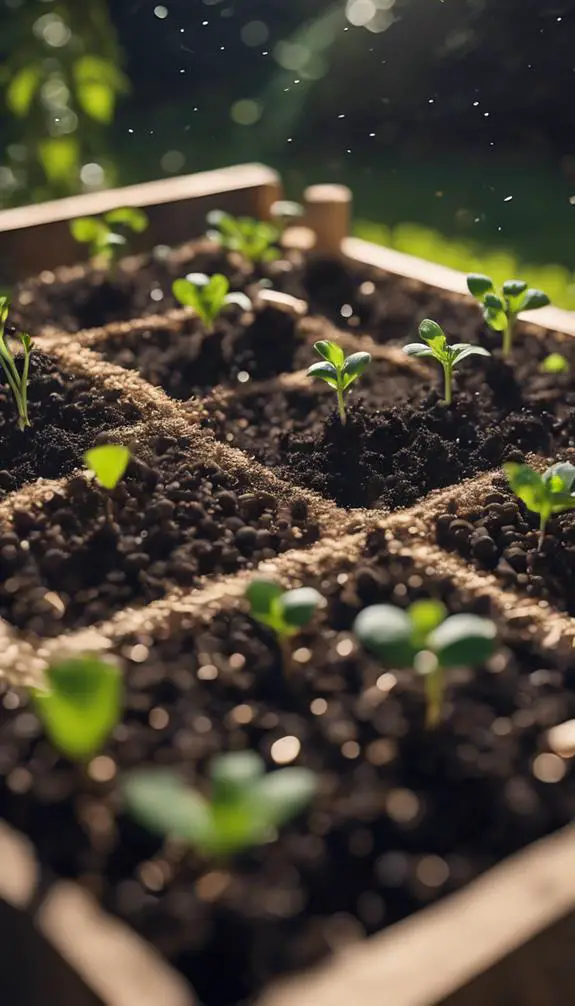
One key aspect of straw bale gardening is integrating compost and fertilizer to create a nutrient-rich environment for your plants.
You'll want to add compost layers to your straw bale garden, ideally 2-3 inches thick, to provide a slow release of nutrients.
When it comes to fertilizer timing, you'll want to apply it 2-3 weeks before planting to allow the nutrients to break down.
Balance is key, so avoid over-fertilizing, which can harm your plants.
Aim for a balanced fertilizer with a ratio of 10-10-10 (nitrogen-phosphorus-potassium).
Irrigation and Watering Systems
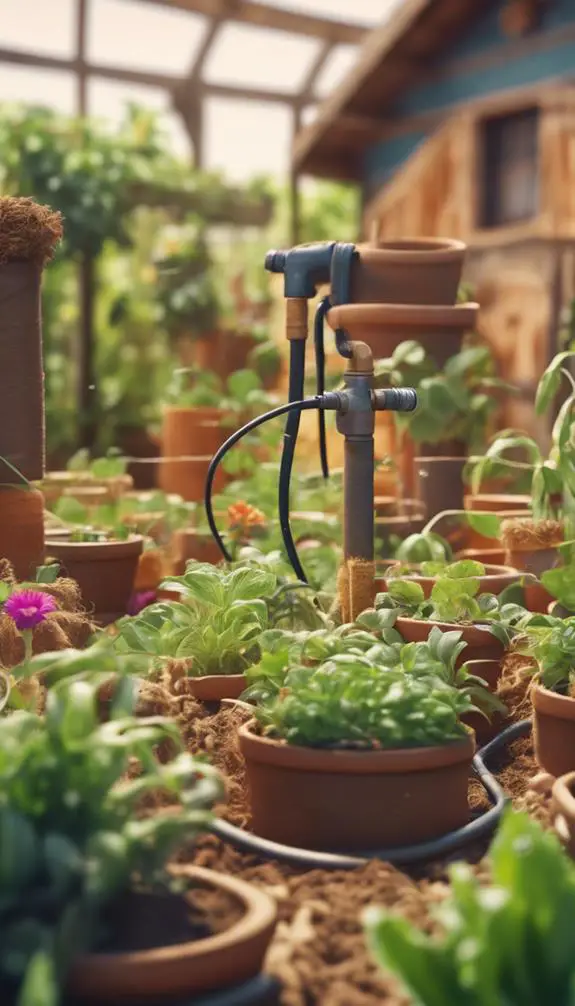
As you've prepared your straw bale garden with compost and fertilizer, it's time to focus on providing your plants with the right amount of water.
You'll want to implement an efficient irrigation system to guarantee your plants receive consistent moisture without waste. Drip irrigation is a top choice for straw bale gardens, as it delivers water directly to the roots, reducing evaporation and runoff.
This method also encourages healthy root growth and minimizes weed growth. Alternatively, you can use sprinkler systems, which are better suited for larger gardens or those with dense plantings.
Regardless of the method, make sure to water your straw bales regularly, especially during hot and dry spells.
Crop Selection and Rotation
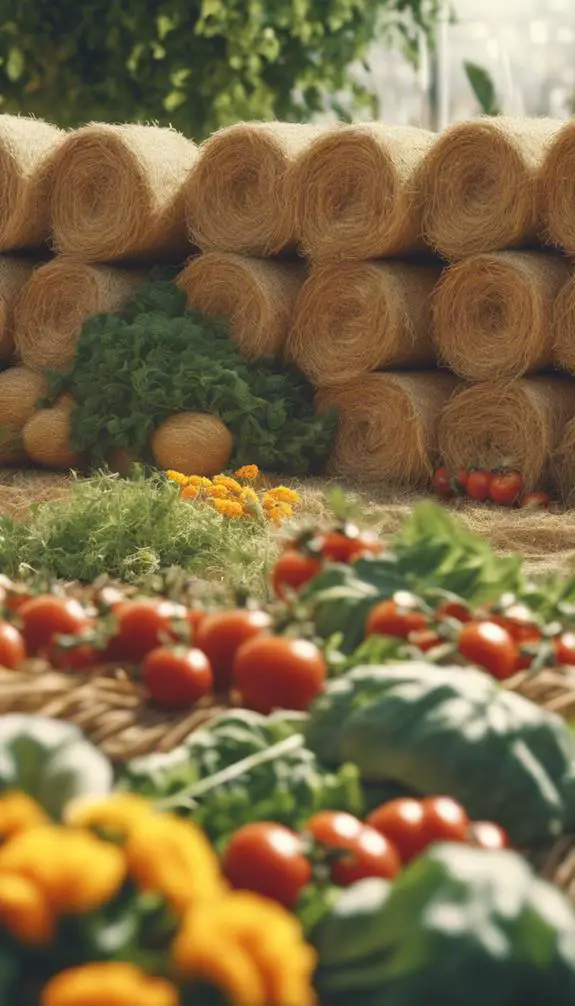
Three key factors influence the success of your straw bale garden: climate, soil, and crop selection.
When choosing crops, consider your local climate and the specific growing conditions of your straw bale garden. Opt for crop diversity to certify a balanced and resilient ecosystem.
Select a mix of warm-season and cool-season crops to maximize yields throughout the year. For seasonal planning, divide your crops into three categories: spring, summer, and fall.
This will help you rotate crops effectively, reducing pests and diseases while maintaining soil health. By planning ahead and selecting the right crops for your straw bale garden, you'll be on your way to a thriving and productive harvest.
Companion Planting Strategies

Beyond the benefits of crop rotation, companion planting strategies can further enhance the health and productivity of your straw bale garden.
You can adopt buddy planting techniques, where complementary vegetables or flowers are paired together to improve growth, flavor, or pest resistance.
For instance, planting marigolds with tomatoes can deter nematodes, while basil repels pests that target tomatoes.
Flower pairing is another effective strategy, where flowers like nasturtiums, which repel aphids, are planted alongside vulnerable crops like cabbage.
Managing Pests and Diseases
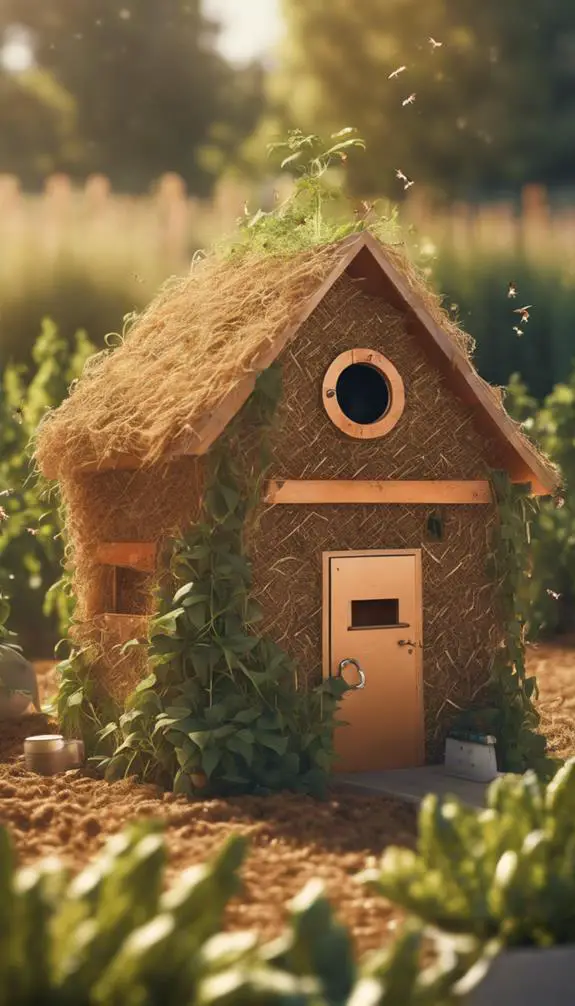
By the time your straw bale garden is in full swing, pests and diseases may start to emerge, threatening to undo all your hard work.
Regular pest monitoring is vital to identify issues early on. Keep an eye out for signs of pests like holes in leaves, white powdery residue, or actual insects on your plants.
For disease prevention, maintain good air circulation and remove any infected plants immediately. You can also use organic fungicides or bactericides to treat fungal or bacterial infections.
Additionally, encourage beneficial insects like ladybugs and lacewings, which prey on pests, to visit your garden by planting a diverse range of flowers and herbs. By being proactive, you'll be able to minimize damage and keep your straw bale garden thriving.
Seasonal Maintenance and Care

As you've successfully managed pests and diseases, it's time to focus on the ongoing upkeep of your straw bale garden.
Seasonal maintenance is vital to guarantee your garden remains thriving throughout the year. During winter prep, clear any debris, and add a layer of compost to protect the bales from harsh weather conditions.
As you shift between seasonal themes, adjust your irrigation system and fertilization schedule accordingly. For instance, reduce watering during winter months and increase it during spring when plants are actively growing.
Regularly inspect your bales for signs of decomposition and replace them as needed. By staying on top of seasonal maintenance, you'll be able to enjoy a bountiful harvest all year round.
FAQs
Can I Use Straw Bales That Are Moldy or Rotten?
You shouldn't use moldy or rotten straw bales, as they can harbor diseases and pests. Instead, opt for fresh alternatives, ensuring high bale quality, which is vital for a healthy and thriving garden.
How Do I Keep Straw Bales From Toppling Over in Wind?
To prevent straw bales from toppling over in wind, you'll need to secure them properly. You can create wind barriers using stakes or fencing, and then anchor each bale with bale stakes to keep them upright and stable.
Are Straw Bales Safe for Growing Vegetables for Pregnant Women?
When growing veggies as a pregnant woman, you'll want to guarantee fetal safety; straw bales are generally safe, as nutrient transfer from the bale to your crops is minimal, and bacteria like Listeria are unlikely to contaminate your harvest.
Can I Use Straw Bales for Container Gardening on a Balcony?
When you're urban gardening on a balcony, you'll face constraints like wind, sunlight, and space. You can adapt by using straw bales as containers, which will save space and provide insulation, but guarantee you choose a variety that's compact and lightweight for balcony gardening.
Do Straw Bales Attract Rodents and Other Unwanted Pests?
You'll want to ponder pest control methods when using straw bales, as they can attract rodents and other unwanted pests. Implementing rodent deterrents, like sealing entry points and using repellents, will help minimize the risk of infestation in your balcony garden.
Conclusion
You've carefully planned and executed your straw bale gardening layout, ensuring ideal growing conditions for a thriving harvest. Remember to regularly monitor and adjust your setup as needed, incorporating crop rotation and companion planting strategies to minimize pests and diseases. With seasonal maintenance and care, your straw bale garden will flourish, providing a bountiful yield and a sense of accomplishment.


